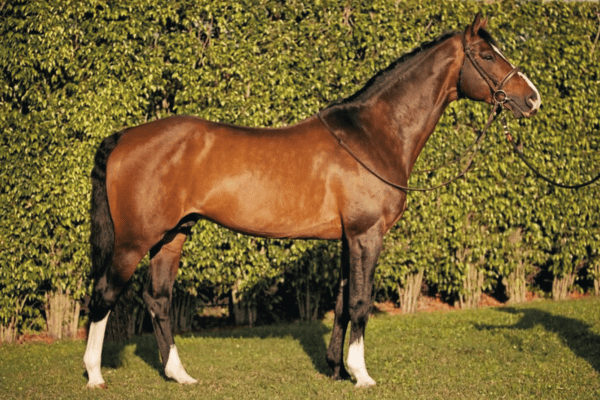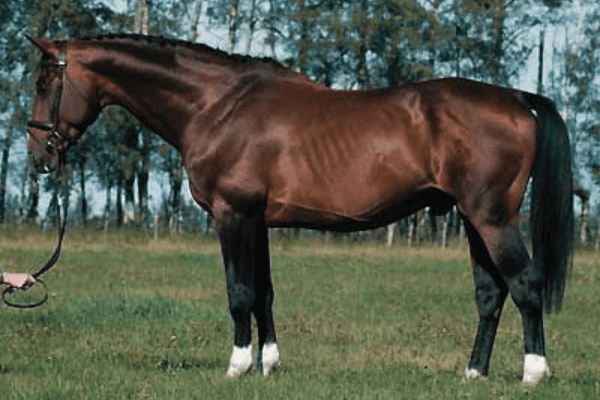The Swiss Warmblood, alternatively known as Schweizer Warmblut or the Neue Einsiedler, stands as a distinguished representative of Switzerland’s equestrian excellence. This breed, a testament to careful and innovative breeding practices, emerged in the mid-20th century as a culmination of several esteemed equine lineages.
It is a product of integrating the ancient Einsiedler breed, a historical mainstay of the Benedictine Monastery at Einsiedeln in the Canton of Schwyz, with the robust and versatile Swiss Halfblood. Further diversifying its genetic makeup are contributions from localized breeds such as the Ajoie, Erlenbacher, and Entlebucher.
Today, the Swiss Warmblood is synonymous with top-tier sport horse performance, thanks to its breeding at the prestigious Haras National Suisse located in Avenches, Canton of Vaud. This breed, embodying both the cultural heritage and the forward-looking vision of Swiss equestrianism, continues to excel in various sporting disciplines, making it a prized asset in both national and international equestrian circles.
History:
Within the intricate tapestry of horse breeding history, the Swiss Warmblood stands out as an integral and distinctive thread. Since its conception in the mid-20th century, its inception embodies both historical equine lineages and innovative breeding practices that set a new standard in sport horses.
It was born of strategic amalgamations between several venerable breeds such as Einsiedler (bred at Benedictine Monastery in Einsiedeln for centuries) and various regional breeds like Ajoie Erlenbacher Entlebucher which all became part of this new lineage.
Unification was so profound that individual strains eventually faded away to be replaced by one robust breed. A dedicated stud-book was established in 1950 as a formal recognition and conservation measure, and in the 1960s additional influences such as Ivoire, Orinate de Messil, Que d’Espair, Holsteiners Astral and Chevalier and Swedish Warmblood Aladin began crossing to increase genetic pool diversity within Swiss Warmblood breed. Crossbreeding expanded qualities and versatility further while simultaneously expanding cross-breeding capabilities within its lineage.
By the turn of the 21st century, Swiss Warmblood horses had cemented their place within global equestrian society. Registration numbers during the early 2010s indicated a robust and expanding population – estimated between 9,000-10,000 individuals by 2017 (750 breeding mares and 77 stallions).
Unfortunately, however, their journey has not been without hardships; by 2023 the FAO listed this breed as at risk/endangered on DAD-IS database, signaling its critical importance for conservation efforts to preserve such an esteemed breed for future generations.

Physical Characteristics:
A Swiss Warmblood horse typically stands 15.2- 16.3 hands (62 to 67 inches). These horses exhibit a well-proportioned and muscular build, showing off the strength and power inherent to their breed lineage.
Their faces feature expressive faces with kind eyes; their coats come in various shades from bay, chestnut, black, to gray – traits highly valued by breeders and owners alike. They are known for their robust health and long lifespan – traits valued by breeders and owners alike.
Temperament and Trainability:
One of the hallmarks of Swiss Warmblood horses is their temperment. Famed for their calm and even-tempered nature, these horses make working with them a delight; intelligent learners that eagerly accept new lessons, willing learners who naturally collaborate well and naturally prefer working cooperatively – these horses make ideal partners for riders of various skill levels. But don’t take this agreeableness for granted: these energetic horses remain passionately committed when working at dressage, jumping or any equestrian sport activity.
Uses:
The Swiss Warmblood, known for its versatility and athleticism, plays an integral part in various equestrian disciplines. From competitive sports to recreational riding, its use demonstrates its adaptability and appeal across a broad spectrum of riders.
Show Jumping: One of the primary arenas where Swiss Warmblood horses excel is show jumping. Their combination of natural athleticism, powerful build and agility make them ideal contenders for taking part in jumping courses with grace and precision. Reputations is held among these horses as reliable jumpers able to maneuver intricate courses effortlessly.
Dressage: Dressage puts the Swiss Warmblood’s elegance and disciplined nature front and center. These horses are known for their smooth movements and ability to perform intricate maneuvers necessary for dressage competitions, with riders being able to rely on subtle cues from them as partners in this discipline.
Eventing: The Swiss Warmblood’s adaptability shines through in eventing, an equestrian sport combining dressage, cross-country racing and show jumping. Their endurance, speed and jumping ability make them standout competitors for this difficult sport.
Driving: In addition to riding disciplines, Swiss Warmblood horses can also be utilized for driving events and recreational carriage driving. Their strength and steady temperament make them suitable for competitive as well as recreational carriage driving events.
Recreational Riding: Swiss Warmbloods have long been prized as recreational riding horses due to their gentle temperament and intelligence, making them suitable for riders of various skill levels–beginners included!
Therapeutic Riding: Due to their gentle temperament and steady gait, Arabian horses make excellent candidates for therapeutic riding programs designed to provide physical and emotional therapy services for individuals with special needs.

Conservation and Breeding:
The Swiss Warmblood stands out among warmblood breeds as one of the least prolifically bred. Breeders in Switzerland remain focused on maintaining its high standards for health, ability, temperament and temperament – with The Swiss Warmblood Association playing an instrumental role in safeguarding these qualities and promoting them internationally.

